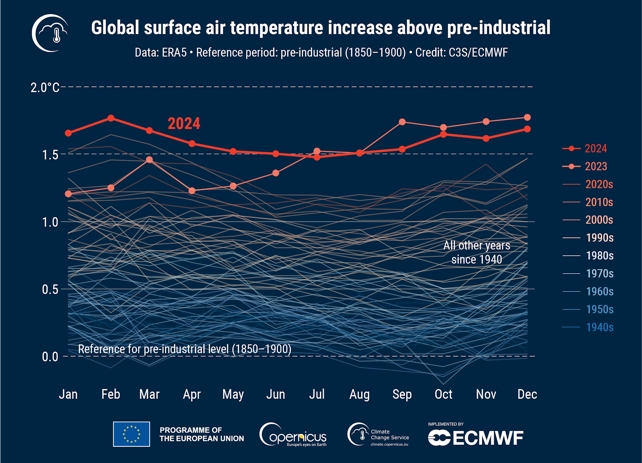The year 2024 was the world’s warmest on record globally, and the first calendar year in which global temperatures exceeded 1.5°C above its pre-industrial levels.
The official declaration was made on Friday by the Copernicus Climate Change Service, the European Union’s Earth observation program. It comes as wildfires continue to tear through Los Angeles, California – a disaster scientists say was made worse by climate change.
This record-breaking global heat is primarily driven by humanity’s ongoing greenhouse gas emissions, caused by the burning of fossil fuels. The warming won’t stop until we reach net-zero emissions.
Clearly, the need for humanity to rapidly reduce its greenhouse gas emissions has never been more urgent.

An exceptional year
The Copernicus findings are consistent with other leading global temperature datasets indicating 2024 was the hottest year since records began in 1850.
The global average temperature in 2024 was about 1.6°C above the average temperatures in the late-19th century (which is used to represent pre-industrial levels).
On July 22 last year, the daily global average temperature reached 17.16°C. This was a new record high.
Copernicus also found that each year in the last decade was one of the ten warmest on record. According to Copernicus director Carlo Buontempo:
We are now teetering on the edge of passing the 1.5ºC level defined in the Paris Agreement and the average of the last two years is already above this level.
These high global temperatures, coupled with record global atmospheric water vapour levels in 2024, meant unprecedented heatwaves and heavy rainfall events, causing misery for millions of people.
How scientists take Earth’s temperature
Estimating the global average surface temperature is no mean feat. The methods vary between organisations, but the overall picture is the same: 2024 was the world’s hottest year on record.
The high global average temperature of 2024 wouldn’t have been possible without humanity’s greenhouse gas emissions. The El Niño climate driver also played a role in the first part of the year. It warmed Earth’s surface – particularly over a large swathe of the central and eastern Pacific – and increased global average surface temperature by up to 0.2°C.
What about Australia?
Copernicus found 2024 was the warmest year for all continental regions except Antarctica and Australasia.
But Australia is feeling the shift into a hotter, less hospitable climate, too. Last year was Australia’s second-hottest year on record, according to a declaration last week by the Bureau of Meteorology.
The hottest was 2019, when a blisteringly hot and dry spring led to the widespread bushfires of the Black Summer. Unlike 2019, Australia had a wetter than normal year in 2024.
However, 2024 was the hottest year on record for the southwest of Australia and parts of the centre and east of the continent.
Apart from April, Australia saw unusual warmth through all of 2024. August was the standout month for record-breaking heat.
In general, temperature records are broken more easily at the global scale than in individual regions. That’s because weather is more variable at the local level than on a global average. A period of, say, very cold weather in one part of a continent can bring down annual average temperatures there, preventing records from being broken.
That’s why Australia’s annual average temperatures have reached record highs three times since 2000 – in 2005, 2013 and 2019 – whereas the global average temperature set six new records in that period.
Does this mean the Paris Agreement has failed?
The global Paris Agreement aims to limit global warming to 1.5°C above pre-industrial levels. So, if 2024 was about 1.6°C above pre-industrial levels, you might think the world has failed to meet this goal. But it hasn’t, yet.
The success of the Paris Agreement will be measured against longer temperature periods than one year. That approach eliminates natural climate variability and factors such as El Niño and La Niña, to build a clearer picture of climate change.
However, the statistics for 2024 are certainly a bad sign. It shows humanity has its work cut out to keep global warming well below 2°C, let alone 1.5°C.
More heat guaranteed
There’s one very important thing to understand about climate change: the amount of greenhouse gases that humans emit over time is roughly proportional to the increase in global temperatures over that same period.
This near-linear relationship means every tonne of greenhouse gas emissions from human activity causes about the same amount of global warming. So, the faster we decarbonise the global economy, the sooner we can halt global warming and reduce its harms.
This year is unlikely to be quite as hot as 2024 because the El Niño has passed. But unfortunately, Earth will continue to experience record hot global temperatures for at least the next few decades.
This is all the more reason for humanity to move faster in decarbonising our society and economy. It’s not too late to shift the long-term trajectory of Earth’s climate.![]()
Andrew King, Associate Professor in Climate Science, ARC Centre of Excellence for 21st Century Weather, The University of Melbourne and David Karoly, Professor emeritus, The University of Melbourne
This article is republished from The Conversation under a Creative Commons license. Read the original article.









Leave a Comment